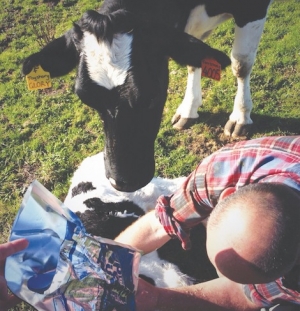However, colostrum can also be a source of some major infectious diseases to calves such as E. coli, Salmonella, Bovine Johne’s Disease and Mycoplasma.
These pathogens can be shed directly into colostrum from an infected cow or can be a result of faecal contamination during the collection and storage process.
Along with the direct disease-causing effects of these pathogens, their presence interferes with the absorption of colostral antibodies by the calf, thus reducing their immunity to disease.
The hygienic collection, storage and subsequent feeding of colostrum to newborn calves is a multi-step process.
This process is time-consuming and allows many opportunities for contamination of colostrum.
Typically on farm, colostrum is collected from freshly calved cows and stored in buckets.
But there may be many more steps before this colostrum is actually fed to the calf such as the transfer to other buckets, smaller containers, tube feeders and teat feeders.
Research has shown that very little bacteria is present in colostrum taken directly from the udder.
In one study, there was nearly four times the bacteria present in colostrum from the dairy-floor bucket compared to that taken directly from the udder.
Possible sources of contamination include the teat skin, milking cup liners, hoses or the bucket itself. Sub-optimal cleaning of collection buckets will exacerbate this problem.
When collecting colostrum, the first milk produced in the udder, it is essential that cups are put on clean dry teats.
Stainless steel collection buckets are preferable to plastic ones as they are easier to clean and do not become scratched.
Daily washing of all collection (and feeding equipment) is vital to prevent the accumulation of pathogens.
Colostrum and milk residues should be washed off with lukewarm water first.
Then add 60ml household bleach per 20 litres of hot water and a ‘squirt’ of detergent and thoroughly scrub all surfaces. Allow buckets and feeding equipment to dry upside down.
Over the past decade, colostrum and waste milk have been the topic of much research looking to reduce bacterial content and improve transfer of immunity to calves.
Various processes have been described from traditional pasteurisation to treatment with UV light.
In the early days of this research, traditional pasteurisation produced a product that was thick in consistency and too difficult to feed. In addition, the pasteurisation process destroyed antibodies to unacceptable levels.
However, researchers continued to develop and refine the heat-treatment process and have established a method that kills the major pathogens in colostrum but also maintains antibody levels.
It is important to emphasise that this process is referred to as ‘heat-treatment’ as opposed to ‘pasteurisation’ because the temperature and duration of treatment do not meet the specifications of traditional heat pasteurisation.
Independent research has shown that compared to other processes, such as UV treatment, heat-treatment of colostrum offers superior killing ability of E. coli, Salmonella, E. coli, Bovine Johne’s Disease and Mycoplasma and has significantly less impact on antibody levels.
A study in the US showed that calves fed heat-treated colostrum had better transfer of immunity at 24 hours of age compared to calves fed fresh, raw colostrum. The same calves had a significantly reduced risk of scours or any other illness in the pre-weaning period.
A shortfall of fresh colostrum may arise at the beginning of calving.
Storage of colostrum, either in the refrigerator or freezer, allows convenient availability at all times but is not without its challenges.
Dairy farmers commonly say that the collection of colostrum, transferring into a container, freezing, defrosting and then transferring into a tube feeder, is a slow and inefficient process. All these steps increase the risk of contamination.
The Perfect Udder colostrum management system allows colostrum to be transferred directly into one bag, which can then be refrigerated, frozen, thawed, reheated or even heat-treated before being fed directly to the calf.
There is no need to transfer colostrum between containers, improving efficiency and biosecurity. The Perfect Udder bags are single-use and come in two sizes: 3 litre and 4 litre allowing colostrum to be delivered in a single feed for larger calves. Smaller calves may need this volume split between two feeds.
Heat-treatment of colostrum can be done as a batch prior to filling the bags or within the bags themselves. The design of the bags allows rapid and efficient thawing after freezing.
• Gemma Chuck is a veterinarian with The Vet Group, based in western Victoria. www.thevetgroup.com.au
















